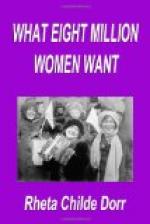Organized labor has always been friendly to woman suffrage, but in Chicago not only the union women but the union men are actively friendly towards the cause. The original moving spirit in the Chicago organization was a remarkable young working girl, Josephine Casey. Miss Casey sold tickets at one of the stations of the Chicago Elevated, and she formed her first woman suffrage club among the women members of the Union of Street and Elevated Railway Employees. Later she organized on a larger scale the Women’s Political Equality Union, with membership open to men and women alike. The interest shown in the union by workingmen, many of whom had never before given the matter a moment’s thought, was, from the first, extraordinary. During the first winter of the society’s existence, union after union called for Woman Suffrage speakers. Addresses were made before fifty or more. Some of the more popular speakers often made four addresses in an evening. Mrs. Raymond Robins, president of the National Women’s Trade Union League, and Miss Alice Henry, secretary of the Chicago branch of the League, won many converts by their expositions of the exceedingly favorable labor laws of Australia and New Zealand, where women vote.
[Illustration: MEETING A RELEASED SUFFRAGETTE PRISONER.]
Unquestionably the mighty battle which is waging in England made a deep impression on American women of all classes. The visits made in this country by Mrs. Cobden Sanderson, Mrs. Borrman Wells, Mrs. Philip Snowden, and, most of all, Mrs. Pankhurst, leader of the militant English Suffragists, aroused tremendous enthusiasm from one end of the country to the other. Never, until these women appeared, telling, with rare eloquence, their stories of struggle, of arrest and imprisonment, had the vote appeared such an incomparable treasure. Never before, except among a few enthusiasts, had there existed any feeling that the suffrage was a thing to fight for, suffer for, even to die for.
Up to this time the suffrage was a theory, an academic question of right and justice. After the visits of the English women, American suffragists everywhere began to view their cause in the light of a political movement. They began to adopt political methods. Instead of private meetings where suffrage was discussed before a select audience of the already convinced, the women began to mount soap boxes on street corners and to talk suffrage to the man in the street.
The first suffrage demonstration was held in New York in February, 1908. The members of a small but enthusiastic Equal Suffrage Club announced their intention of having a parade. Most of the women being wage earners they planned to have their parade on a Sunday. When they applied at Police Headquarters for the necessary permit they found to their disgust that Sunday parades were forbidden by law.
“Not unless you are a funeral procession,” said the stern captain of the police.




